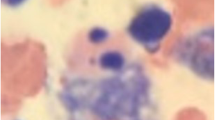Abstract
Lysinuric protein intolerance (LPI; MIM 222700) is an inherited aminoaciduria with an autosomal recessive mode of inheritance. Biochemically, affected patients present with increased excretion of the cationic amino acids: lysine, arginine, and ornithine. We report the first case of LPI diagnosed in Malaysia presented with excessive excretion of homocitrulline. The patient was a 4-year-old male who presented with delayed milestones, recurrent diarrhea, and severe failure to thrive. He developed hyperammonemic coma following a forced protein-rich diet. Plasma amino acid analysis showed increased glutamine, alanine, and citrulline but decreased lysine, arginine and ornithine. Urine amino acids showed a marked excretion of lysine and ornithine together with a large peak of unknown metabolite which was subsequently identified as homocitrulline by tandem mass spectrometry. Molecular analysis confirmed a previously unreported homozygous mutation at exon 1 (235 G > A, p.Gly79Arg) in the SLC7A7 gene. This report demonstrates a novel mutation in the SLC7A7 gene in this rare inborn error of diamino acid metabolism. It also highlights the importance of early and efficient treatment of infections and dehydration in these patients. Conclusion: The diagnosis of LPI is usually not suspected by clinical findings alone, and specific laboratory investigations and molecular analysis are important to get a definitive diagnosis.

Similar content being viewed by others
References
Kato T, Sano M, Mizutani M (1989) Homocitrullinuria and homoargininuria in lysinuric protein intolerance. J Inher Metab Dis 12:157–161
Oyanagi K, Miura R, Yamanouchi T (1970) Congenital lysinuria: a new inherited transport disorder of dibasic amino acids. J Pediatr 77:259–66
Palacin M, Bertran J, Chillaron J, Estevez R, Zorzano A (2004) Lysinuric protein intolerance: mechanism of pathophysiology. Mol Genet Metab 81:S27–S37
Pitt J, Eggington M, Kahler SG (2002) Comprehensive screening of urine samples for inborn errors of metabolism by electrospray tandem mass spectrometry. Clin Chem 48(11):1970–1980
Rajantie J (1981) Orotic aciduria in lysinuric protein intolerance: dependence on the urea cycle intermediates. Pediatric Res 15(2):115–119
Simell O, Perheentupa J, Rapola J, Visakorpi JK, Eskelin LE (1975) Lysinuric protein intolerance. Am J Med 59(2):229–240
Simell O (2002) Lysinuric protein intolerance and other cationic aminoacidurias. In: CR Scriver, AL Beaudet, SW Sly, D Valle (eds) The metabolic and molecular bases of inherited disease, (Chapter 192). Available from: http://genetics.accessmedicine.com
Sperandeo MP, Andria G, Sebastio G (2008) Lysinuric protein intolerance: update and extended mutation analysis of the SLC7A7 gene. Hum Mutat 29(1):14–21
Acknowledgements
We thank the Director General of Health Malaysia for the permission to publish this paper. Our special thanks to Dr. Shahnaz Murad, Director of Institute for Medical Research Kuala Lumpur, and Dr. Rohani Md Yasin, Head of Specialised Diagnostic Centre, for the critical reading of the manuscript and valuable comments. We wish to acknowledge the expert technical assistance of Professor Johannes Häberle and Miss Dana Leiteritz from the Division of Metabolism, University Children’s Hospital and University of Zurich, Switzerland in the molecular diagnosis of the proband. This case study was funded by a diagnostic fund from the Ministry of Health where most of the authors work (except the author from Australia).
Conflict of interest
We declare no conflict of interest.
Author information
Authors and Affiliations
Corresponding author
Rights and permissions
About this article
Cite this article
Habib, A., Md Yunus, Z., Azize, N.A. et al. Hyperexcretion of homocitrulline in a Malaysian patient with lysinuric protein intolerance. Eur J Pediatr 172, 1277–1281 (2013). https://doi.org/10.1007/s00431-013-1947-1
Received:
Revised:
Accepted:
Published:
Issue Date:
DOI: https://doi.org/10.1007/s00431-013-1947-1



